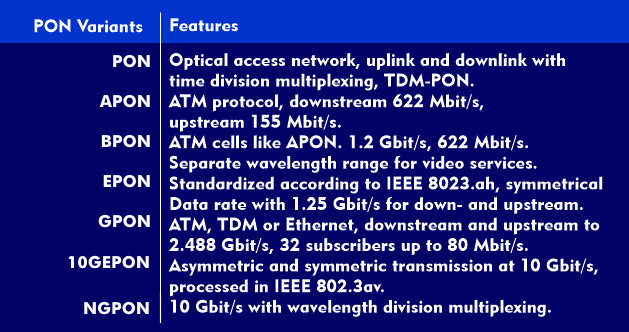passive optical network (PON)
Passive optical networks, Passive Optical Network (PON), also known as optical access networks( OAN), operate exclusively with passive optical components. PONs form the basis for optical access networks (OAN), they are constructed in tree topology, directly connected to the core network and have optical distribution networks( ODN) as branches.
The different PON variants
PON technology comes in a wide variety of variants and implementations, including the Broadband Passive Optical Network( BPON), which, like the ATM implementation ATM over Passive Optical Network( APON), has a transmission rate of 622 Mbps. An increase to 1 Gbit/s can be achieved with the Ethernet Passive Optical Network( EPON), an Ethernet implementation, and with the Gigabit PON( GPON) even transmission rates of 2.5 Gbit/s can be achieved. The 10 Gigabit Ethernet PON, 10GEPON, opens up the connection range for 10 Gigabit Ethernet. Standard PONs are also available as next-generation networks, such as NG-PON and NG-GPON.
In the PON concept, various subscribers can be connected via a fiber optic cable to an access exchange where various services - voice, video, data - are provided. The subscribers are connected to the optical line termination( OLT) via a splitter. The available bandwidth is divided among the number of possible subscribers, maximum 32, and is 32:1 or even 64:1. The extension of such a passive optical network can be about 20 km.
Connection concepts in the passive optical network
The passive optical network can be structured as a point-to-point linkbased on SDH or as a point-to-multipoint link with optical splitters. In this configuration, the signal comes from the Optical Line Termination (OLT) in the local exchange where it is converted to light signals or where the SDH signals are taken over by an Optical Crossconnect( OXC). The optical line terminator (OLT) is responsible for traffic sheduling and is connected to multiple ONTs where the data is queued. PON techniques currently use time-division multiplexing(TDM), and in a few years will also use wavelength-division multiplexing(WDM) to combine multiple TDM-PON on one optical fiber. The transmission directions are separated by using different optical windows. The uplink is at a wavelength of 1,310 nm, the downlink at 1,490 nm.
Connection services in the passive optical network
In PON systems, optical energy can be coupled in or out at any point in the transmission medium via passive optical couplers. The systems operate bidirectionally and are suitable for data transmission of 64 kbit/s services and TV distribution services. They form the basis for FTTx variants in the access area such as Fiber to the Premises( FTTP), Fiber to the Home( FTTH), Fiber to the Building( FTTB), Fiber to the Curb( FTTC), FTTEx, etc. Transmission is in time division multiplex (TDM) or with TDMA.
PON networks are mainly used in the residential sector, where downstream and upstream traffic flows are highly unbalanced in interactive distribution services. There are several PON alternatives that work with standardized protocols such as EPON, which works with the IP protocol, or APON or BPON with ATM.


.png)